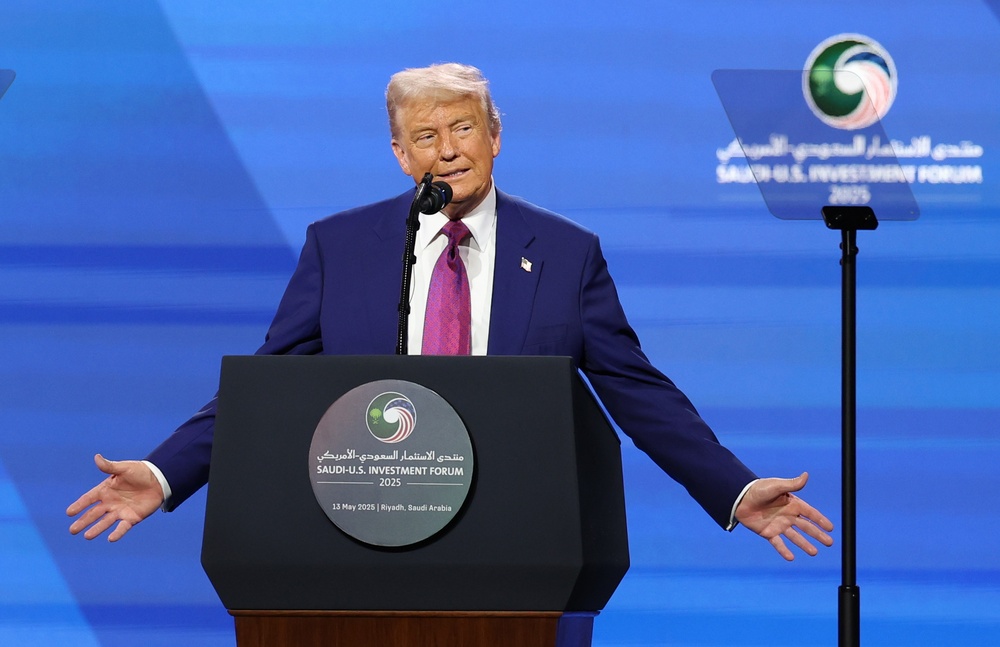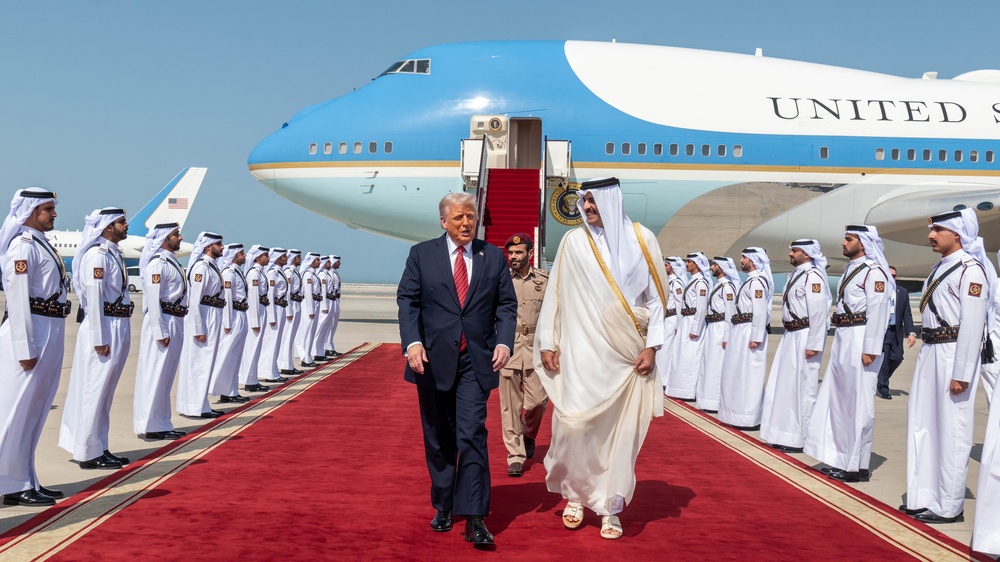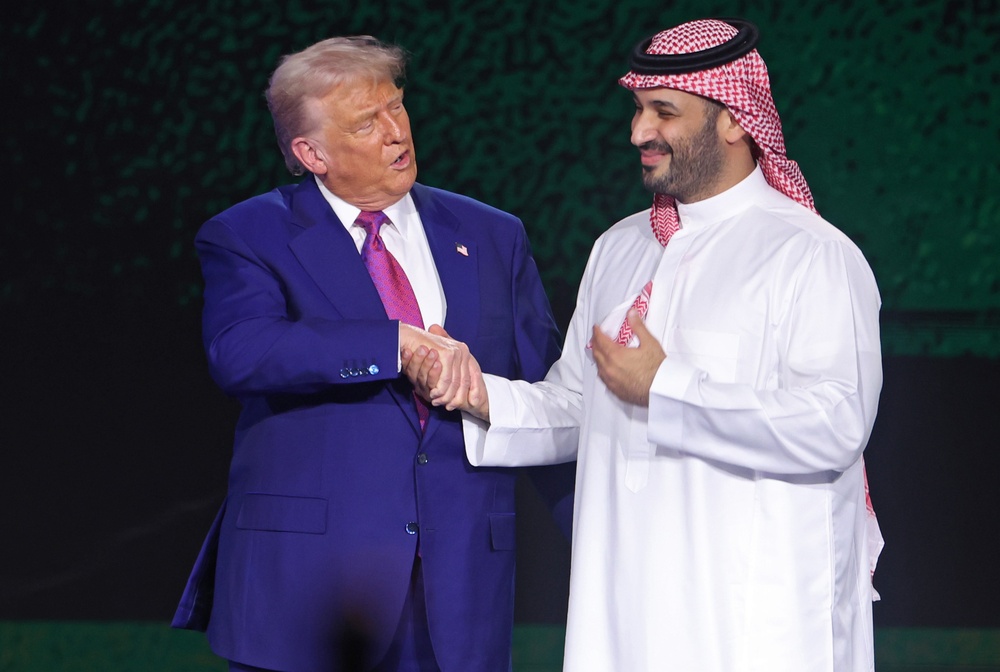
- #Global Issues
- #US Foreign Policy

-
President Trump's second term, marked by a new cabinet and a dramatically
changed global landscape (e.g., ongoing wars in Ukraine, Gaza, and Sudan,
intensified competition with China), is distinct from his first, yet maintains
core themes like immigration and competition with China while escalating
concerns about traditional allies and overseas military commitments.
-
An emerging "Trump Doctrine" in foreign policy prioritizes minimizing
or ending conflicts, limiting sustained American military commitments, and
maximizing economic benefits abroad, as evidenced by his statements and the
recent Middle East trip.
-
This doctrine's practical application in the Middle East includes pressing for
negotiated peace deals (e.g., Gaza, Iran nuclear program), using limited
military force (e.g., Houthi campaign), and securing multi-trillion dollar
economic agreements with Gulf partners, notably framed to counter China's
influence.
For
many American presidencies, the second term is a chance to cement their legacy.
The president, unburdened by the constraints of having to face elections again,
is thus able to pursue foreign and domestic policies of choice. Historically,
the president’s staff largely stayed the same between the first and second
terms in office, providing continuity of thought and process. And world events
are generally consistent with the themes of the president’s first time in
office. Yet in the case of the Second Trump Administration, this is not exactly
the case. President Trump has an entirely new cabinet and inherits a world
decidedly changed since he was last in office. Not for over a hundred years has
an American president served two non-consecutive terms in office, and the
similarities and differences between the first and second Trump terms are
crystallizing.
On
the one hand, many of the focal points of the first Trump administration remain
in the second. The prioritization of immigration, border security, and the
competition with China span both terms. On the other, the aspirations of
territorial expansion (see: Greenland), friction with traditional U.S. partners
and allies (see: NATO), and chafing at America’s vast overseas military
commitments (see: the Houthi campaign) are heightened variations on a similar
theme. The world the second Trump administration inherited is dramatically
different, as well: the U.S. no longer has a military presence in Afghanistan,
the wars in Ukraine, Gaza, and Sudan continue, and the competition with China
has only intensified.
Yet
the Middle East has remained a priority for Trump. In May, he visited Saudi
Arabia, Qatar, and the United Arab Emirates (UAE) for the first official
overseas travel of his second term in office. What emerged during this trip is
the formation of a new foreign policy doctrine, one that starts with the Middle
East but has repercussions for America’s relationships around the world.
The
Trump View of the World
Several
themes are apparent in the foreign policy outlook of the second Trump
administration. One is the president’s own reticence to engage in sustained
military operations overseas. “We will measure our success not only by the
battles we win but also by the wars that we end,” Trump declared in
his second inaugural address, “and perhaps most importantly, [by] the wars we
never get into.” This theme reinforces the president’s preference for ending
wars, such as in Ukraine, as well as his own relationship with the application
of military force. The first Trump administration showed the president is not
averse to select military actions – the 2017 and 2018 Syria strikes and the
2020 Qassem Soleimani operation being noteworthy examples – but his support for
long-term, sustained military operations is rare.
This
viewpoint is reinforced by another foreign policy theme in this administration:
a belief that the costs to American military adventurism abroad far outweigh
any potential benefits. The recent trip to the Middle East offered the
president and his team an opportunity to underscore this belief. Praising the
region’s economic ambitions, Trump noted:
“This great transformation has not come from Western intervention noise or
flying people in beautiful planes giving you lecture on how to live and govern
your own affairs.” He then went on to criticize the historic American approach
to the region in the Global War on Terror (GWoT) era: “In the end, the
so-called nation builders wrecked far more nations than they built and the
interventionalists were intervening in complex societies that they did not even
understand themselves.”
A
few weeks after the trip, Vice President Vance further underscored this
perspective. In an address at the U.S. Naval Academy, he noted “a
generational shift” was taking place in foreign policy, one “grounded in
realism and protecting our core national interests.” The Middle East trip
signified “the end of a decades-long approach in foreign policy that I think
was a break from the precedent set by our founding fathers.” And he further
emphasized: “we had a long experiment in our foreign policy that traded
national defense and the maintenance of our alliances for nation building and
meddling in foreign countries' affairs, even when those foreign countries had
very little to do with core American interests.”
Days
later, the U.S. Ambassador to Turkey and close advisor to the president, Tom
Barrack, further elaborated on this view:
“A
century ago, the West imposed maps, mandates, penciled borders, and foreign
rule. Sykes-Picot divided Syria and the broader region for imperial gain—not
peace. That mistake cost generations. We will not make it again. The era of
Western interference is over. The future belongs to regional solutions, but
[sic] partnerships, and a diplomacy grounded in respect. As President Trump
emphasized in his May 13th address in Riyadh, gone are the days when Western
interventionalists would fly to the Middle East to give lectures on how to
live, and how to govern your own affairs."
Taken
together, the statements by the president and his close advisors suggest an
emerging foreign policy doctrine. This doctrine appears to emphasize minimizing
or ending conflicts, limiting American military commitments, and maximizing
America’s economic benefits abroad. And the Middle East is, once again, the
proving ground for this approach.
The
Trump Doctrine in Practice in the Middle East
In
the Middle East, the application of this emerging foreign policy doctrine is
clear. On the diplomatic front, Trump has repeatedly called for ending
conflicts. Like Ukraine, he has placed a premium on ending the conflict in
Gaza, in both cases applying considerable pressure to traditional American
partners. He has also expressed a desire to
build off the first-term success of his Abraham Accords normalization
agreements between Israel and its regional neighbors by facilitating further
agreements in the region. And he has prioritized a deal with Iran regarding its
nuclear program. The contours and feasibility of achieving any such deal remain
a point of debate, but the president’s prioritization for a negotiated
settlement over military action is clear. “I would prefer that to bombing the
hell out of it,” Trump recently told reporters
when asked about negotiating a nuclear agreement with Iran, “they don’t want to
die. Nobody wants to die.”
On
the military front, the president has likewise demonstrated a willingness to
utilize military force in a limited fashion. Like his first term in office,
Trump remains averse to sustained periods of military operations. The most
notable example was the military campaign against the Houthis in Yemen, which
lasted several weeks before the administration halted operations and pursued a
diplomatic arrangement with the group. In both instances, the belief in
negotiated outcomes that minimize extended American military commitments was
reinforced. “We went in with a clear diplomatic goal,” Vice President
Vance declared,
“not to enmesh our service members in a prolonged conflict with a non-state
actor, but to secure American freedom of navigation.”
And
on the economic front, it is clear this is where Trump remains the most
comfortable. His belief in the power of mutually beneficial economic
arrangements in preserving peace and stability has rarely been more in evidence
than in the Middle East. His recent trip led to the commitment of
trillions of dollars in deals with Gulf partners that spanned various domains.
Notably, the competition with China was also on Trump’s mind during the trip.
Administration officials were quick to point out the disparity between the
trillions announced during this visit and the approximately $50
billion signed during President Xi Jinping’s 2022 visit. Many of the deals in
the technological realm – including over the acquisition of advanced chips –
were framed as limiting China’s influence. “They were going to China, China was
going to be their parent,” Trump told a
reporter during the trip, “that’s not happening anymore.”
Conclusion
The
foreign policy doctrine emerging in the second Trump administration appears to
be centered on negotiating peace deals, strengthening America’s position vis
a vis China, avoiding costly military entanglements, and pressuring
partners and allies to step up. This doctrine is fueled by a world-view that is
highly critical of previous U.S. foreign policies, most notably in the Middle
East where this doctrine is most evident for the moment. The question for
international observers, of course, is whether this doctrine will eventually
extend beyond the Middle East.

Grant Rumley is the Meisel-Goldberger Senior Fellow and director of the Glazer Foundation Program on Great Power Competition and the Middle East at the Washington Institute for Near East Policy, where Claudia Groeling is a research assistant.

